Autosport 19 September 2013

http://i.imgbox.com/acdPo9CJ.jpg
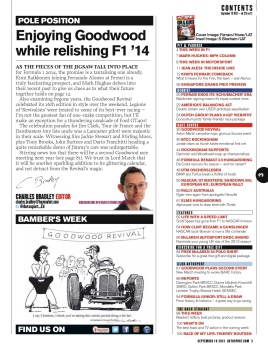

http://i.imgbox.com/adpO3Okw.jpg
http://i.imgbox.com/adwCLTGo.jpg
Jean Alesi-The inside line
Ferrari F1 folk hero on racing at the Goodwood Revival, and what it was like to hear the boos on the Monza podium a week earlier.
Whenever I tell my friends outside motor racing that I’m racing at Goodwood, I always say that cannot explain just how incredible it actually is.It is always amazing!I first came here in 2000 for the Festival of Speed. That is more like a big party, more a big show, but the Revival is a real racing event like no other. What makes it so special is that everyone plays their part: not just the drivers, but the public too – just look at the grandstand and the pits. It’s the most beautiful event in terms of historic racing for me.As a driver, you need a lot of respect for the Goodwood circuit. The speeds are high, easily reached, and in these types of car the high-speed conditions makes them very interesting to drive. You need to think about the safety of the car when you’re driving; you have to be respectful about that too. The attitude behind the wheel is not ‘drive to the maximum’ but to enjoy these wonderful moments. I think everyone would like my position to drive a car like the 250 GTO – I’m not an ex-Formula 1 driver in this car, I’m just a lucky guy!I also really enjoyed being on the podium at Monza the week before; that was also a magic moment. I spoke with Adrian Newey and Christian Horner over the weekend at Goodwood, and I told them that all the boos were not against Vettel or Red Bull, it’s just that the public there are all Ferrari fans. I remember when I first moved from Ferrari to Benetton, I finished second behind Michael. I didn’t get a boo, but I’m sure if I had to speak, like they have to now,I would have been booed!Red Bull and Vettel are doing such a great job, they deserve their success. It’s not luck or coincidence they keep winning. Sure, last year, Fernando Alonso was unlucky twice at the start, in Belgium and Japan, and he drove a super championship but he didn’t have the car or the speed to win on the track. This year, Red Bull are making perfect weekends with the car, the strategy and the pitstops.Now Ferrari has signed Kimi Raikkonen to partner Fernando next year. Following the whole story, I think Fernando made a big mistake when he started to fight Ferrari. They had to prepare the team in case he wanted to
quit. When he was looking around there was no room for him anywhere else, at one stage it looked like he was thinking to have one year off. At Ferrari, they cannot have Massa and a young driver.
So I am sure they prepared the Kimi deal with that in mind. I know the announcement was after Monza, but I am sure they already had something signed when Fernando was upset and Kimi was available.As I know from my time at Ferrari, when they sacked Alain Prost, you cannot criticise a team like Ferrari. All the big teams, with their huge effort and budgets, their image cannot be attacked by any driver.How will Kimi and Fernando be as team-mates? You know, it’s like the beginning of a marriage. After the wedding we will see what happens – sometimes it doesn’t last very long!It’s going to be interesting to see how they compare. I think the role of [team principal] Stefano Domenicali is going to be more difficult. Straight away he must be clear with both of them, although Kimi is not the kind of guy who listens to rumours or reads the newspapers. It will be easy for Domenicali from Kimi’s side, it’s Fernando who will have to understand that the cake is now cut into two parts! I think Ferrari is not just looking to compete for the driver's championship but also the constructors’.Felipe Massa did eight years with Ferrari and he’s done a great job, working hard – sometimes he was like Fernando’s test driver on a grand prix Friday. Sometimes you have sacrifice someone to change the spirit in a team.I think the comeback of Kimi with Lotus, after his years away in rallying has been amazing. He was not rallying like he drove in F1 – he was just enjoying himself with less pressure. He has been extremely into it since he came back, and Romain Grosjean is not a bad driver at all to compare his speed against. Some people don’t realise that Kimi is a
sensitive guy, he’s not an animal in the way he behaves as so many people think.I’m sure Kimi will push Fernando more next year.
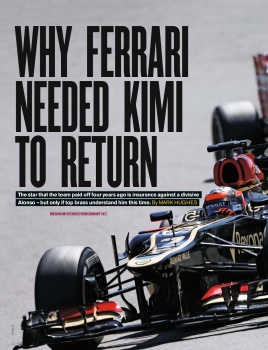
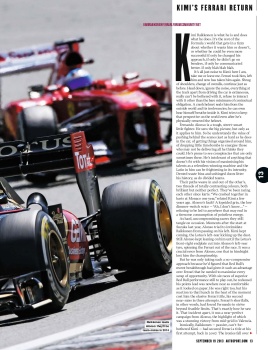
http://i.imgbox.com/abhBHA8L.jpg
http://i.imgbox.com/acuNa1dX.jpg
Kimi Raikkonen is what he is and does what he does. It’s the rest of the Formula 1 world that gets in a tizzy about whether it wants him or doesn’t, or whether he could be even more successful if only he changed his approach, if only he didn’t go on benders, if only he communicated
better. If only blah blah blah. It’s all just noise to Kimi: here I am, take me or leave me. Ferrari took him, left him and now has taken him again. Shrug of shoulders, change of overalls, continue just as before. Head down, ignore the noise, everything at the track apart from driving the car is extraneous, really can’t be bothered with it, refuse to interact with it other than the bare minimum of contractual obligation. A crash helmet seals him from the outside world and its irrelevancies; he can even hear himself breathe inside it. Kimi tries to keep that perspective on the world even after he’s physically removed the helmet. Fernando Alonso is a tough, street-smart little fighter. He sees the big picture, but only as it applies to him. So he understands the value of pushing behind the scenes just as hard as he does in the car, of getting things organized around him, of dropping little time bombs to energize those who may not be delivering all he thinks they could. He’s prone to see conspiracies that are only sometimes there. He’s intolerant of anything that
doesn’t fit with his vision of maximizing his talents as a relentless winning machine and the Latin in him can be frightening in its intensity. Dented waste bins and unhinged doors litter
his history, as do divided teams. Their paths weave in and out of the others,two threads of totally contrasting colours, both brilliant but neither perfect. They’ve been racing each other since karts. “We crashed together in karts at Monaco one year,” related Kimi a few years ago. Alonso’s fault? A lopsided grin, the low dimmer-switch voice – “Ah, I don’t know...” – refusing to be led to anywhere that may end in a tiresome consumption of pointless energy. As hard, uncompromising racers they still tangle on occasion. Moments after the start at Suzuka last year, Alonso tried to intimidate Raikkonen from passing on his left. Kimi kept coming, the Lotus’s left-rear kicking up the dust.
Still Alonso kept leaning on him until the Lotus’s front-right endplate cut into Alonso’s left-rear
tyre, spinning the Ferrari out of the race. It was a crucial error from Alonso, one that in hindsight
lost him the championship. But he was only taking such a no-compromise approach because he’d figured that Red Bull’s recent breakthrough had given it such an advantage over Ferrari that he needed to maximize every scrap of opportunity. With six races of superior Red Bull performance still to play out, he reckoned his points lead was nowhere near as comfortable
as it looked on paper. He was right too, but his reaction to that hunch in the heat of the moment cost him the elusive Ferrari title, his second near-miss in three attempts. Ferrari’s shortfalls,
in other words, had forced Fernando to strive beyond feasible limits. That’s exactly how he saw it. That incident apart, it was a near-perfect campaign from Alonso, the highlight of which was a stunning victory from mid-grid in Valencia. Ironically, Raikkonen – passive, can’t-be- bothered Kimi – had secured Ferrari a title at his first attempt, back in 2007. The ironies fall over themselves in the parallel histories of this pair. Raikkonen was able to win that championship partly because Alonso had contributed to an implosion at McLaren and helped get the team sanctioned for industrial espionage. There was never any prospect after that of his seeing out his three-year contract with the team. Alonso was released after a single season there, leaving devastation in his wake. “Fabulous driver,” said a senior McLaren man, “but a complete bastard.” If there is a flaw in a team Alonso will find it. He found Ron Dennis-era McLaren’s neurotic nerve and kept pressing it until it ejected him.
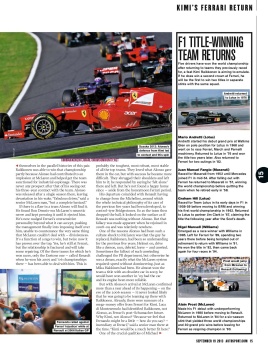

http://i.imgbox.com/abrbkcFb.jpg
http://i.imgbox.com/adpXbyHM.jpg
He’s now nudged Ferrari’s oversensitive personality beyond what it can accept, pushing the management finally into imposing itself over him, unable to countenance the very same thing that McLaren couldn’t deal with – divisiveness. It’s a function of a rage to win, but twice now it
has proven over the top. Yes, he’s still at Ferrari, but the relationship is fractured and will take some repairing. Of the three teams for which he’s won races, only the Enstone one – called Renault when he won his 2005 and ’06 championships there – has been able to deal with him. This is probably the toughest, most robust, most stable of all the top teams. They loved what Alonso gave them in the car, but with success he became more difficult. They shrugged their shoulders and left him to it; he responded by saying he ‘felt alone’ there and left. But he’s not found a happy home since – aside from the honeymoon Ferrari period. His departure coincided with Renault having to change from the Michelins, around which the whole technical philosophy of its cars of the previous five years had been developed, to control-tyre Bridgestones. So as the team then dropped the ball, it looked on the surface as if Renault was nothing without Alonso. But that fallacy was made apparent when he rejoined in 2008-09 and was relatively nowhere. One of the reasons Alonso had been such a
culture shock to McLaren was that the guy he replaced, Raikkonen, had been so undemanding for the previous five years. Helmet on, drive like a demon, race, debrief, leave – and unwind Sometimes the fallout of such unwinding challenged the PR department, but otherwise he was a dream, exactly what the McLaren system required: speed without domineering. Just as Mika Hakkinen had been. He almost won the team a title with an obsolete car in 2003; he would have won another in ’05 had the car and its engine been more reliable. But with Alonso’s arrival at McLaren confirmed more than a year ahead of its happening – on the eve of the 2006 season – it never looked likely that he was going to be teaming up there with Raikkonen. Already, there were rumours of a mega-money offer from Ferrari for Kimi. Luca di Montezemolo had identified Raikkonen, not Alonso, as Ferrari’s post-Schumacher future. Why Kimi, not Alonso? “Because we feel that Fernando might be a little – how do you say? – incendiary at Ferrari,” said a senior man there at the time. “Kimi would be a much better fit here.”
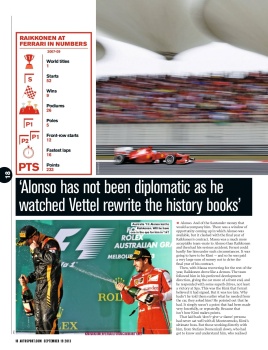
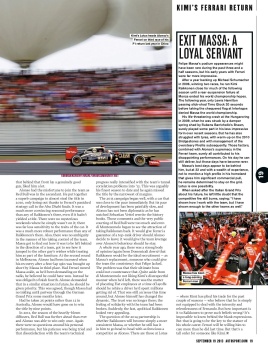
http://i.imgbox.com/abbbejKf.jpg
http://i.imgbox.com/abmmGv4a.jpg
One of the crucial qualities of Michael Schumacher during his time at Ferrari was that no matter how demanding he was behind the scenes, he never made even a raised eyebrow of public criticism of the team. The later antipathy between Alonso and Ferrari at Monza 2006, and Fernando’s very public raging at the injustice of what he saw as the governing body’s complicity with his rival in the championship fight after it penalized him on highly dubious grounds for impeding Felipe Massa during qualifying, just further convinced Ferrari it had chosen the right man. So Kimi joined Ferrari for 2007, won on his debut, won the title too. But he wasn’t always the devastatingly quick driver we’d seen at McLaren. It took half a season for him to establish himself over Massa, a driver who had averaged half a second slower than Schumacher the previous year. The latter half of Raikkonen’s 2007 campaign was, however, genuinely impressive and that momentum carried through into the early part of ’08. But thereafter he seemed to lose competitive direction and Massa steadily gained the upper hand, so that it was the Brazilian who carried the team’s title hopes into that final round. It was much the same with the less- competitive ’09 car, Felipe the more consistent, Kimi on vastly more money and apparently disinterested. Between the summers of ’08 and ’09 Raikkonen only rarely looked like the great driver that Ferrari believed it had hired. That was bad enough, but what was worse, in Ferrari’s eyes, was his apparent acceptance of the situation. For his part, he felt that Ferrari had followed a development direction that favoured Massa’s less-subtle driving style. He relayed this and left it at that. Ferrari began to join the dots between its lack of progress and Raikkonen’s passive attitude. Perhaps it really did need a true team leader, an inspirational figure who got involved in the nitty-gritty, who pushed for solutions, who was like a dog with a bone until the problems were resolved. Like Schumacher.
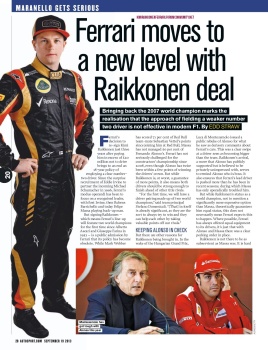
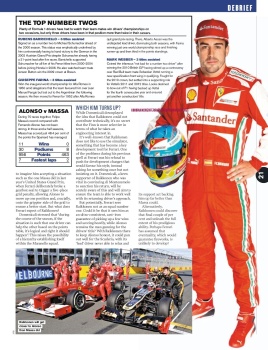
http://i.imgbox.com/abiEmxjf.jpg
http://i.imgbox.com/adyy6Cdz.jpg
Di Montezemolo began to think in terms of Alonso. And of the Santander money that would accompany him. There was a window of opportunity coming up in which Alonso was available, but it clashed with the final year of Raikkonen’s contract. Massa was a much more acceptable team-mate to Alonso than Raikkonen and then had his serious accident; Ferrari could hardly fire him under such circumstances. It was going to have to be Kimi – and so he was paid a very large sum of money not to drive the final year of his contract. Then, with Massa recovering for the rest of the year, Raikkonen drove like a demon. The team followed him in his preferred development direction, giving the car more of a front end, and he responded with some superb drives, not least a victory at Spa. This was the Kimi that Ferrari believed it had signed. But it was too late. Why hadn’t he told them earlier what he needed from the car, they asked him? He pointed out that he had. It simply wasn’t a point that had been made very forcefully, or repeatedly. Because that isn’t how Kimi makes points. That laid back ‘don’t-give-a-damn’ persona had never sat well with di Montezemolo, Kimi’s ultimate boss. But those working directly with him, from Stefano Domenicali down, who had got to know and understand him, who realized hat behind that front lay a genuinely good guy, liked him a lot.Alonso had the misfortune to join the team as Red Bull was in the ascendant. He put together a superb campaign to almost steal the title in 2010, only losing out thanks to Ferrari’s panicked strategy call in the Abu Dhabi finale. It was a much more convincing seasonal performance than any of Raikkonen’s three, even if it hadn’t yielded a title. There were no mysterious weekends where he simply wasn’t on it; there was far less sensitivity to the traits of the car. It was a much more robust performance than any of Raikkonen’s there. Also, there was no ambiguity in the manner of his taking control of the team. Massa got to find out how it was to be left behind in the direction of a team, got to see how it jumped to the other guy’s wishes while treating him as part of the furniture. At the second round in Melbourne, Alonso had been incensed when his recovery after a first-lap spin was brought up short by Massa in third place. Had Ferrari moved Massa aside, as he’d been demanding on the radio, he believed he could have won. Instead he was obliged to finish fourth. Alonso demanded that in a similar situation in future, he should be given priority. This was agreed, though Massa had no inkling until partway through the German Grand Prix some months later. Had he taken 25 points rather than 12 in Australia, Alonso would have gone on to win the title by nine points. In 2011, the season of the heavily-blown diffusers, Red Bull was further ahead than ever and Alonso was able to win only once. Again there were no questions around his personal performance, but his patience was being tried and that dissatisfaction with the team’s technical progress really intensified with the team’s tunnel correlation problems into ’12. This was arguably his finest season to date and he again missed the title by the narrowest of margins. The 2013 campaign began well, with a car that was close to the pace immediately. But its pace of development has been painfully slow, and Alonso has not been diplomatic as he has watched Sebastian Vettel rewrite the history books. Those comments and the very public courting of Red Bull were too much and even di Montezemolo began to see the attraction of taking Raikkonen back. It would give Ferrari a guarantee of a top-rank driver should Alonso decide to leave; it would give the team leverage over Alonso’s behaviour should he stay. A whole year ago, there was a strong body of opinion (again from Domenicali down) that Raikkonen would be the ideal recruitment – as Massa’s replacement, someone who could give the team the consistency that Felipe lacked. The problem was that their ultimate boss could not countenance that. Quite aside from di Montezemolo not liking Kimi’s disrespectful manner when he’d left, there was the matter of placating Fiat employees at a time of layoffs should he rehire a driver he’d spent millions getting rid of. That was still an issue this time around, but Alonso himself has changed the dynamic. The trust was no longer there; the feeling of solidarity with the team had been broken. Suddenly, the fast, apolitical Raikkonen looked very appealing. The question of the 2014 partnership is whether Raikkonen will become simply a more consistent Massa, or whether he still has it in him to go head to head with as ferocious a competitor as Alonso. There are those at Lotus – where Kimi has plied his trade for the past couple of seasons – who believe that he is simply not equipped to deal with the intensity and relentlessness of Fernando. But how important is it to Raikkonen to prove such beliefs wrong? It’s impossible to know behind the blank expressions. But that is going to be the key to the stature of his whole career. Ferrari will be willing him to care more than he did last time. But that’s a tall order for someone like Kimi.
Ferrari moves to a new level with Raikkonen deal.
Bringing back the 2007 world champion marks the realization that the approach of fielding a weaker numbertwo driver is not effective in modern F1.
By Edd Straw
Ferrari’s decision to re-sign Kimi Raikkonen just three years after paying him in excess of £20 million not to drive brings to an end an 18-year policy of employing a clear number two driver. Since the surprise recruitment of Eddie Irvine to partner the incoming Michael Schumacher in 1996, Ferrari’s modus operandi has been to focus on a recognised leader, with first Irvine, then Rubens
Barrichello and today Felipe Massa playing back-up man. But signing Raikkonen which means Ferrari’s line-up will feature two world champions for the first time since Alberto Ascari and Giuseppe Farina in 1953 is a public admission by Ferrari that its policy has become obsolete. While Mark Webber has scored 71 per cent of Red Bull team-mate Sebastian Vettel’s points since joining him at Red Bull, Massa has not managed 50 per cent of Fernando Alonso’s. Ferrari has not seriously challenged for the constructors’ championship since 2008, even though Alonso has twice been within a few points of winning the drivers’ crown. But while Raikkonen is, at worst, a guarantee of more points, it also means both drivers should be strong enough to finish ahead of other title rivals. “For the first time, we will have a driver pairing made up of two world champions,” said team principal Stefano Domenicali. “[That] in itself is already significant, as they are the sort to always try to win and they can help each other by taking valuable points off our rivals.”
KEEPING ALONSO IN CHECK
But there are other reasons for Raikkonen being brought in. In the wake of the Hungarian Grand Prix Luca di Montezemolo issued a public rebuke of Alonso for what he saw as derisory comments about Ferrari’s cars. This was a clear swipe at a driver seen as becoming bigger than the team. Raikkonen’s arrival, a move that Alonso has publicly supported but is believed to be privately unimpressed with, serves to remind Alonso who is boss. It also ensures that Ferrari’s lead driver is pushed more than he has been in recent seasons, during which Massa has only sporadically troubled him. But while Raikkonen’s status as a world champion, not to mention a significantly more expensive option than Massa, theoretically guarantees him equal status, this does not necessarily mean Ferrari expects this to happen. Where possible, Ferrari has always offered equal equipment to its drivers, it’s just that with Alonso and Massa there was a clear pecking order in place. Raikkonen is not there to be as subservient as Massa was. It is hard to imagine him accepting a situation such as the one Massa did in last year’s United States Grand Prix, when Ferrari deliberately broke a gearbox seal to trigger a five-place grid penalty, allowing Alonso to move up one position and, crucially, onto the grippier side of the grid to ensure a better start. But what does Ferrari expect of Raikkonen? Domenicali stressed that “during the course of the season, if the situation is such that one driver can help the other based on the points table, it’s logical and right it should happen” This raises the possibility of a hierarchy establishing itself within the Maranello squad.
WHICH KIMI TURNS UP?
While Domenicali downplayed the idea that Raikkonen could not contribute technically, it’s no secret
that the Finn is more selective in terms of what he takes an engineering interest in. It’s well-known that Raikkonen does not like to use the simulator, something that has become a key development tool for Ferrari. One of the problems during his previous spell at Ferrari was his refusal to
push for development changes that would favour his style, instead asking for something once but not insisting on it. Domenicali, a keen supporter of Raikkonen who was vital in convincing di Montezemolo to sanction his return, will be acutely aware of this and will aim to ensure the team is able to work well with its returning driver’s approach. But potentially, Ferrari sees
Raikkonen not as an equal number one. Could it be that it sees him as an ultra consistent, cast iron guarantee of picking up a few wins and scoring heavily, while Alonso remains the man gunning for the drivers’ title? With Raikkonen there to keep Alonso honest, it could pan out well for the Scuderia, with its ‘lead’ driver never able to relax and its support act backing
him up far better than Massa could. Alternatively, Raikkonen could discover that final couple of per cent and unleash the full extent of his prodigious ability. Perhaps Ferrari has assumed that eventuality, which would guarantee fireworks, is unlikely to develop?



